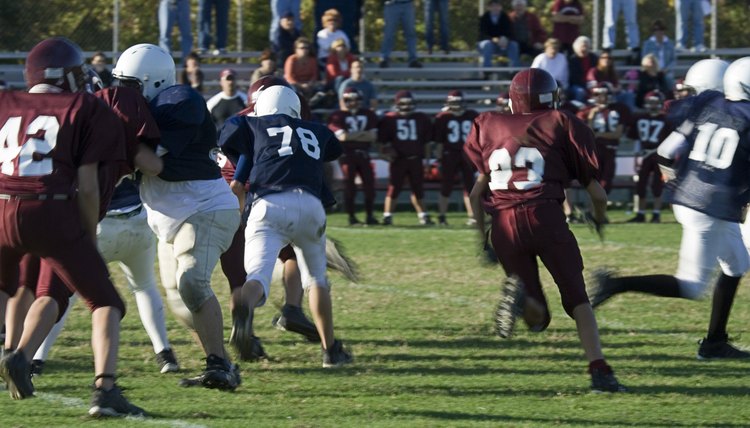What Is the Best Offense & Defense to Run in High School Football?

Despite the physicality ingrained in the sport, football is a popular activity for children of a wide range of ages. Children as young as 5 and as old as 17 embrace the sport with gusto and enthusiasm. However, the diverse span of ages requires different styles of play to suit the abilities of each age group. For example, Bantum level football features almost no forward passing -- nearly all offensive plays are runs and draws. At the high school level, the offensive and defensive systems are more elaborate, but certain limitations persist because of the wide variability of player attributes.
Football in High School
Even though high school players are all in the same basic age group -- 15 to 18 -- that group spans a range of physiological differences. Adolescents in this age group develop and mature at varying rates, creating a huge disparity between players of the same age. In many ways, football is a sport that requires the exploitation of matchups for success; the huge variability makes game-planning and installing schemes difficult, because the results are more prone to unpredictability.
Goals and Success
Obviously, the goal of a high school football team is to consistently win, execute plays and push toward the playoffs. However, especially at the high school level, an often unspoken goal of football is the development of certain interpersonal and leadership skills that come with working as a team, sacrificing individual interests for a larger community goal and to take responsibility for one’s own mistakes in a direct way. The best high school offensive and defensive systems will be the ones that best encourage team chemistry and cohesiveness.
Effective Offense
At the high school level, the best offense will usually be the one that maintains control of the ball for more of the game than the opponent. Systems that focus on the run, such as the Wishbone, the Power-I, the Single Wing and the Read-Option, are common at the high school level. However, spread offenses are becoming more popular and may suit certain teams. Despite the common misconception, a spread attack isn’t really a vertical passing system. The spread attack depends on effective blocking by the offensive line to push the defense out laterally, clearing space for runs up the middle, out to the side, for screens or for vertical passing off of play-action passing. Without quick, physically imposing offensive linemen, the spread option may not be ideal for the high school level.
Dynamic Defense
High school defensive systems depend greatly on the type of talent on the roster, and the type of offenses that the team will face in its league. Usually, to counter ground-control running attacks, a 4-4-3 defense is ideal, because it places four defensive linemen on the line of scrimmage, with four defensive players at the second level to contain power runs or short passes. If the threat of deep, vertical passing isn’t likely from a lot of teams in the league, the defensive secondary usually doesn’t need more than three players to contain it.
References
Writer Bio
Bobby R. Goldsmith is a writer and editor with over 12 years of experience in journalism, marketing and academics. His work has been published by the Santa Fe Writers Project, "DASH Literary Journal," the "Inland Valley Daily Bulletin" and WiseGEEK.
